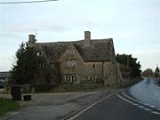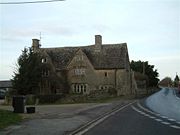
Brighthampton
Encyclopedia
Brighthampton is a hamlet
about 4 miles (6.4 km) south of Witney
in West Oxfordshire
and contiguous with the village of Standlake
.
burial ground from the 5th and 6th centuries AD has been found south of Malthouse Farm (OS grid reference SP382033) in Brighthampton.
Brighthampton's toponym
means Beorhthelm's tūn. In the 10th century it was part of the royal manor
of Bampton
, and in AD 984 Æthelred II gave land at Brighthampton to one of his ministers. The Domesday Book
records that in 1086 William the Conqueror
's half-brother Odo, Bishop of Bayeux was Brighthampton's feudal
overlord. However, William I imprisoned Odo from 1082 until 1087 and confiscated his lands. In 1131 Henry I
granted land at Brighthampton to Sées
Priory
in Normandy
. This is likely to have been the same land that William I had confiscated from Odo. At the same time Henry granted land at Hardwick
to the same priory, and these together became a single manor of Hardwick and Brighthampton.
There is a record from early in the 17th century of Brighthampton having a stone cross, and in 1857 it was recorded that there was still the base of an "ancient" stone cross (presumably mediaeval) at the hamlet's central crossroads.
 Forge Cottage is a 16th century timber-framed building supported by a central cruck
Forge Cottage is a 16th century timber-framed building supported by a central cruck
. By 1776 it was trading as a public house
, the Red Lion. Another pub in Brighthampton, the Golden Balls, had been licenced by 1753. It was rebuilt early in the 20th century, ceased trading in 1992 and was demolished in 1994.
The farmhouse of Manor Farm (also called Florey's Farm) is of Cotswold stone
and was built early in the 17th century. It was extended in the middle of the 17th century and again in the 19th century.
were recorded in the parish in the latter part of the 17th century, and in the 18th century several local families were Anabaptist
s who attended a chapel in Cote
. A Baptist
chapel was built between Brighthampton and Standlake in 1832, flourished in the 1840s and 50's and a gallery was added to increase capacity in 1865. In the 20th century falling attendances led to services being discontinued in 1937, but they were resumed in 1951. The chapel finally closed in 1978 and in 1994 it was serving as the offices of a missionary society. It is now a private house.
Hamlet (place)
A hamlet is usually a rural settlement which is too small to be considered a village, though sometimes the word is used for a different sort of community. Historically, when a hamlet became large enough to justify building a church, it was then classified as a village...
about 4 miles (6.4 km) south of Witney
Witney
Witney is a town on the River Windrush, west of Oxford in Oxfordshire, England.The place-name 'Witney' is first attested in a Saxon charter of 969 as 'Wyttannige'; it appears as 'Witenie' in the Domesday Book of 1086. The name means 'Witta's island'....
in West Oxfordshire
West Oxfordshire
West Oxfordshire is a local government district in north west Oxfordshire, England including towns such as Woodstock, Burford, Chipping Norton, Charlbury, and Witney ....
and contiguous with the village of Standlake
Standlake
Standlake is a village and civil parish about southeast of Witney and west of Oxford. The parish includes the hamlet of Brighthampton. The River Windrush flows past the village and with its tributary Medley Brook it forms much of the eastern boundary of the parish. The western boundary has been...
.
History
A large paganGermanic paganism
Germanic paganism refers to the theology and religious practices of the Germanic peoples of north-western Europe from the Iron Age until their Christianization during the Medieval period...
burial ground from the 5th and 6th centuries AD has been found south of Malthouse Farm (OS grid reference SP382033) in Brighthampton.
Brighthampton's toponym
Toponymy
Toponymy is the scientific study of place names , their origins, meanings, use and typology. The word "toponymy" is derived from the Greek words tópos and ónoma . Toponymy is itself a branch of onomastics, the study of names of all kinds...
means Beorhthelm's tūn. In the 10th century it was part of the royal manor
Manorialism
Manorialism, an essential element of feudal society, was the organizing principle of rural economy that originated in the villa system of the Late Roman Empire, was widely practiced in medieval western and parts of central Europe, and was slowly replaced by the advent of a money-based market...
of Bampton
Bampton
- England :* Bampton, Cumbria* Bampton, Devon** Bampton railway station**Bampton * Bampton, Oxfordshire- Other :*Bampton Island, former name of Parama Island, Papua New Guinea*Bampton Reefs, Chesterfield Islands, New Caledonia- People :...
, and in AD 984 Æthelred II gave land at Brighthampton to one of his ministers. The Domesday Book
Domesday Book
Domesday Book , now held at The National Archives, Kew, Richmond upon Thames in South West London, is the record of the great survey of much of England and parts of Wales completed in 1086...
records that in 1086 William the Conqueror
William I of England
William I , also known as William the Conqueror , was the first Norman King of England from Christmas 1066 until his death. He was also Duke of Normandy from 3 July 1035 until his death, under the name William II...
's half-brother Odo, Bishop of Bayeux was Brighthampton's feudal
Feudalism
Feudalism was a set of legal and military customs in medieval Europe that flourished between the 9th and 15th centuries, which, broadly defined, was a system for ordering society around relationships derived from the holding of land in exchange for service or labour.Although derived from the...
overlord. However, William I imprisoned Odo from 1082 until 1087 and confiscated his lands. In 1131 Henry I
Henry I of England
Henry I was the fourth son of William I of England. He succeeded his elder brother William II as King of England in 1100 and defeated his eldest brother, Robert Curthose, to become Duke of Normandy in 1106...
granted land at Brighthampton to Sées
Sées
Sées is a commune in the Orne department in north-western France.It lies on the Orne River from its source and north-by-northeast of Alençon.-Name:...
Priory
Priory
A priory is a house of men or women under religious vows that is headed by a prior or prioress. Priories may be houses of mendicant friars or religious sisters , or monasteries of monks or nuns .The Benedictines and their offshoots , the Premonstratensians, and the...
in Normandy
Normandy
Normandy is a geographical region corresponding to the former Duchy of Normandy. It is in France.The continental territory covers 30,627 km² and forms the preponderant part of Normandy and roughly 5% of the territory of France. It is divided for administrative purposes into two régions:...
. This is likely to have been the same land that William I had confiscated from Odo. At the same time Henry granted land at Hardwick
Hardwick, West Oxfordshire
Hardwick is a village on the A415 road, in the parish of Hardwick-with-Yelford, in the West Oxfordshire District, in the English county of Oxfordshire....
to the same priory, and these together became a single manor of Hardwick and Brighthampton.
There is a record from early in the 17th century of Brighthampton having a stone cross, and in 1857 it was recorded that there was still the base of an "ancient" stone cross (presumably mediaeval) at the hamlet's central crossroads.
Historic buildings

Cruck
A cruck or crook frame is a curved timber, one of a pair, which supports the roof of a building, used particularly in England. This type of timber framing consists of long, generally bent, timber beams that lean inwards and form the ridge of the roof. These posts are then generally secured by a...
. By 1776 it was trading as a public house
Public house
A public house, informally known as a pub, is a drinking establishment fundamental to the culture of Britain, Ireland, Australia and New Zealand. There are approximately 53,500 public houses in the United Kingdom. This number has been declining every year, so that nearly half of the smaller...
, the Red Lion. Another pub in Brighthampton, the Golden Balls, had been licenced by 1753. It was rebuilt early in the 20th century, ceased trading in 1992 and was demolished in 1994.
The farmhouse of Manor Farm (also called Florey's Farm) is of Cotswold stone
Cotswold stone
Cotswold stone is a yellow oolitic limestone quarried in many places in the Cotswold Hills in the south midlands of England. When weathered, the colour of buildings made or faced with this stone is often described as 'honey' or 'golden'....
and was built early in the 17th century. It was extended in the middle of the 17th century and again in the 19th century.
Baptist chapel
A few families of nonconformistsNonconformism
Nonconformity is the refusal to "conform" to, or follow, the governance and usages of the Church of England by the Protestant Christians of England and Wales.- Origins and use:...
were recorded in the parish in the latter part of the 17th century, and in the 18th century several local families were Anabaptist
Anabaptist
Anabaptists are Protestant Christians of the Radical Reformation of 16th-century Europe, and their direct descendants, particularly the Amish, Brethren, Hutterites, and Mennonites....
s who attended a chapel in Cote
Cote, Oxfordshire
Cote is a hamlet about south of Witney and north of the River Thames in West Oxfordshire, England. Cote is part of the civil parish of Aston, Cote, Shifford and Chimney...
. A Baptist
Baptist
Baptists comprise a group of Christian denominations and churches that subscribe to a doctrine that baptism should be performed only for professing believers , and that it must be done by immersion...
chapel was built between Brighthampton and Standlake in 1832, flourished in the 1840s and 50's and a gallery was added to increase capacity in 1865. In the 20th century falling attendances led to services being discontinued in 1937, but they were resumed in 1951. The chapel finally closed in 1978 and in 1994 it was serving as the offices of a missionary society. It is now a private house.

